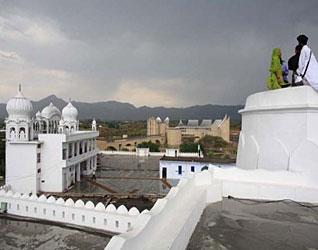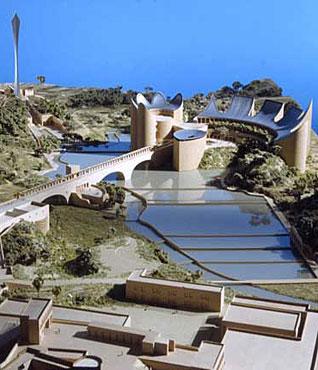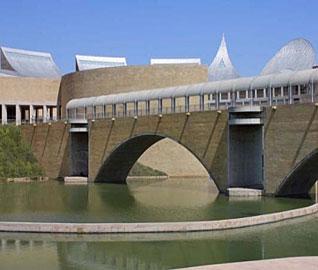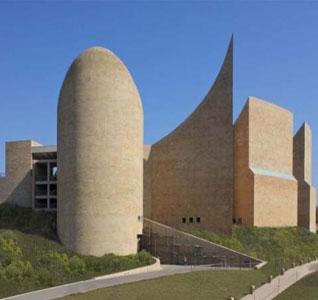Architecture
The Khalsa Heritage Project
by MEGHA MANN
In 1999, the tercentenary year of the Birth of the Khalsa, the Government of Punjab announced that it would build a Khalsa Heritage Complex at Anandpur Sahib to commemorate the epoch-making event.
The project, an inspiring tribute to the heroic and poignant saga of the Sikhs and Punjab, stands amidst mountains on a sprawling 100-acre area.
Dubbed as a "wonder in the making", the complex has been conceived to project the history and culture of Sikhs on an international scale.
TRIBUTE TO TRADITION
The project, which has been shaped like hands offering prayers, unfolds Sikh history and tradition like never before. People working on the project claim that a museum like this has never been built before in the country. It has no precedent, no comparison.
Made up of building materials from across the subcontinent, the project is an architectural miracle and the world's foremost comprehensive Sikh heritage centre.
Moshe Safdie, the internationally acclaimed Boston-based Israeli architect, has designed the Khalsa Heritage Complex.
The project houses a museum, which will have souvenirs related to Sikh history comprising all of the Ten Sikh Gurus, Guru Granth Sahib and Sikh rulers like Maharaja Ranjit Singh. The museum will also house scriptures written by Guru Gobind Singh.
The museum is conceived by Amardeep Behl, a Delhi-based designer running AB Design Habit, who is also working on the restoration of Harmandar Sahib.
The project has two main complexes, which are joined with a connecting ceremonial bridge. The canopy on this bridge is an architectural experiment and is situated in the opposite direction of the sun and does not provide any shade.
The western complex houses an auditorium with a seating capacity of 400. It will have temporary exhibition galleries and a library, housing all journals, magazines, books and periodicals on Sikhism.
The eastern complex has a north wing also known as the Flower Building. Its other wing is called the Boat Building or the Heritage Section.
The roof of the Flower Building is shaped in the form of five petals - representing the Panj Piaras - the Five Cherished Ones - of Vaisakhi fame. Each petal will house an exhibit tracing the life history of all the Gurus from birth to attaining salvation/ martyrdom. These will be permanent exhibits. The petal at the highest altitude will have information and exhibits on Guru Granth Sahib.
The rooftops of all the petals have been covered with special stainless steel sheets. At night, the entire building will be illuminated with its large silhouette being reflected in the seven acres around of water around it. It will also illuminate the night skyline of the historical city of the birth of the Khalsa.
EXHIBIT GALLERIES
At the entry of the museum, permanent exhibits depicting Punjab before the birth of Guru Nanak have been placed. These will showcase the climate, culture and life of pre-Nanak times. The ceiling of this heritage building has been made of glass and its floor will be covered with water. The aim of this exhibit is to make the visitor introspective.
Thematic carpets will adorn walls of this part of building, for which weavers from Mirzapur have been roped in. Next, the visitor is greeted with the thought-provoking concept of Ik Onkar. The Mool Mantar will echo all around this exhibit.
This exhibit, with special sound effects, is situated in a drum-like building where lights will create an image of Ik Onkar and an audio message will highlight the core principles of Sikhism.
Then starts a mesmerizing journey into the lives of the first Five Gurus in the five petals of the flower building. These five petals tell tales from Guru Nanak to Guru Arjan.
The first petal will have the milieu of the times Guru Nanak was born in, tracing his life through the far-flung travels (udasis) he undertook. Further, there will be galleries depicting the lives and contributions of Guru Angad and Guru Amar Das.
One of the galleries is divided into two, by recreating a baoli in the middle, to highlight the latter‘s life work. It will have leather and shadow puppets with painted murals in background.
The gallery in the fourth petal contains exhibits on the contribution of Guru Ram Das, including the construction of the city of Ramdaspur, adding 11 ragas to the existing corpus of Gurbani, and the Laavan. The city of Ramdaspur has been recreated in an embroidered form.
The gallery in the fifth petal showcases key events in the history of Sikhism: the construction of Harmandar Sahib, as well as the compilation and investiture of the Adi Granth. A pathway leading to the gallery will have a replica of Harmandar Sahib. The gallery also has an ethereal, glowing representation of the Parkash Sthan - the place of the Adi Granth in the Harmandar, in the centre.
Around this central installation are shown stories related to the Adi Granth. Four doorways around it recreate different scenes describing the life and times of Guru Arjan.
There is another gallery depicting Guru Arjan's martyrdom in the form of a sculpture on the terrace. Here, the events around the martyrdom have been narrated in an evocative manner without showcasing explicitly bloody and violent scenes, which is usually the case in other museums and exhibits.
There is also an exhibit, which will suggest the coming together of five elements - fire, earth, water, air and space.
The petals in the crescent building will cover the lifespans of Guru Hargobind, Guru Har Rai, Guru Harkrishan, Guru Teg Bahadar, Guru Gobind Singh and Gurta Gaddi.
The galleries at the lower level will chronicle the trials, tribulations and triumphs of the Khalsa, from Banda Singh Bahadar to immediately after Partition, when Sikh dynamism helped revive a truncated Punjab with its elan, energy and resilience.
A TOURIST HUB
The Khalsa Heritage Complex has a great potential to attract a large number of tourists, as the town already attracts millions of pilgrims from around the world to the many historical gurdwaras and Sikh forts in the region.
The Punjab and Himachal Pradesh Governments have proposed a joint ropeway project from Naina Devi - the site where Guru Gobind Singh first recited "Chandi ki Vaar" - the Ode to the Sword - to Anandpur Sahib. Currently, a survey of the area is underway for this project.
Besides these attractions, the Bhakhra-Nangal project and the Nangal wetland offer perfect features for developing this area as a major tourist hub.
But the heritage complex project has been hit hard by the funds crunch, which has delayed its construction. Started by Prakash Singh Badal in 1998, the project ran into rough weather in 2003 with the then chief executive of Anandpur Sahib Foundation (ASF) seeking funds from Sikhs in the diaspora for its continuation.
A year later, a consortium of five banks agreed to finance the project. The Central Government contributed around Rs. 480 million, while the five banks gave Rs. 1 billion. [Roughly, US $1 equals Rs. 48.] The rest of the amount has been spent by the state government.
The government had earlier promised to complete the project by 2004. Later, the deadline was shifted to Baisakhi of this year. But the ASF now plans to inaugurate the project by November of this year.
Modalities are being worked out to recruit staff members for the complex. Work is also on to finalize rare books and manuscripts for the hi-tech library that will be an integral part of complex.
[This article has been edited from its original version in The Tribune.]
June 6, 2009
Conversation about this article
1: Chintan Singh (San Jose, California, U.S.A.), June 08, 2009, 2:44 PM.
While museums and rotating exhibits are good for outreach and education efforts, how about spending some of this money on a school, college or hospital to serve the local community of Anandpur or helping the farmers pay off debts or address the fetus killings problem in Punjab? Wouldn't that be more in line with the Sikh philosophy and also portray the correct Sikh image which is of Sewa and serving humanity? Do we need all of this gold and glitter of thematic carpets and special sound effects? [Editor: We need all of the above, and more!]
2: Satnam (Amritsar, Punjab), June 16, 2009, 4:50 AM.
I appreciate the effort that goes into making such museums and the role they play in preserving the cultural heritage. But I would suggest that a portion of the money put into such projects be used in publishing and distributing high quality books on our religion, history, gurbani, etc.
3: T.N. (U.S.A.), August 06, 2009, 12:05 AM.
Certainly the space itself holds many keys to educating populaces. Perhaps, the museum could offer integrative arts classes geared towards empowering students to awaken dormant talents and experience greater joy. Sometimes supplemental education is as important as traditional education. Even if it allowed students to learn how to work with the technologies installed within, they might have a better chance for future success. The students could even perform on stage, play music or share their arts within the space. Thus, not only would they be learning, they would be contributing to the greater work.
4: Parvinder Singh (India), December 25, 2009, 2:04 AM.
This complex was expected to finish and open by April 2009 but there is no news about it. Even their website is not updated about latest news. Could anyone pass the latest information about it?
5: Jaswant Singh (USA), July 20, 2014, 6:30 PM.
In portraying some of the factors that encouraged Mr. Macauliffe on the path of writing and publishing the 'History of Sikhs', he states in the preface: "Among them I may be allowed to give the following from "The Khalsa", a Sikh publication:-- [This is the terminal part of the quote in Macauliffe's preface]: Unlike the Scriptures of other creeds, they do not contain love stories or accounts of wars waged for selfish considerations. They contain sublimest truths, the study of which cannot but elevate the reader spiritually, morally, and socially. There is not the least tinge of sectarianism in them. They teach the highest and purest principles that serve to bind man to man and inspire the believer with an ambition to serve his fellow men, to sacrifice all and die for their sake. Can someone please trace the original from "The Khalsa" (from the late 1800s) files/archives, if they indeed exist in some library?






